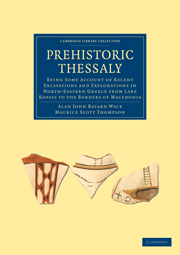 Prehistoric Thessaly
Prehistoric Thessaly Published online by Cambridge University Press: 07 September 2011
The exploration of the prehistoric remains of North Greece may be said to have been begun by Schliemann, when he excavated at the Boeotian Orchomenos in 1880 and 1881. Here he was the first to find in any quantity the grey, wheel-made ware, now so well known, to which he gave the name Minyan. In 1884 Lolling first called attention to the Thessalian mounds, and specially studied those at Dhimíni (Διμήνι) and Sésklo (∑έσκλο), where he collected prehistoric vase fragments, which he submitted to Furtwaengler. In 1886 the first tholos tomb at Dhimini was excavated. In 1889 Wolters published the Mycenean vases from Pagasae in the collection of Mr Periklis Apostolidhis of Vólos (Βόλος). But in spite of the promise of much that was new and interesting ten years passed without any regular excavation in Thessaly. The exploration of the Orchomenos district however proceeded rapidly. In 1891 and 1892 Kambanis and Curtius dealt with the Minyan dykes of Lake Kopais. The following year de Ridder excavated at Orchomenos itself and at Ghulás (Гουλάς). In 1894 Noack published a long account of Chulas in which he noticed other early sites in the same neighbourhood. In 1896 attention was recalled to Thessaly by the discovery of iron age tholos tombs at Marmáriani (Μαρμάριανη), which were further explored by Tsundas in 1899.
To save this book to your Kindle, first ensure [email protected] is added to your Approved Personal Document E-mail List under your Personal Document Settings on the Manage Your Content and Devices page of your Amazon account. Then enter the ‘name’ part of your Kindle email address below. Find out more about saving to your Kindle.
Note you can select to save to either the @free.kindle.com or @kindle.com variations. ‘@free.kindle.com’ emails are free but can only be saved to your device when it is connected to wi-fi. ‘@kindle.com’ emails can be delivered even when you are not connected to wi-fi, but note that service fees apply.
Find out more about the Kindle Personal Document Service.
To save content items to your account, please confirm that you agree to abide by our usage policies. If this is the first time you use this feature, you will be asked to authorise Cambridge Core to connect with your account. Find out more about saving content to Dropbox.
To save content items to your account, please confirm that you agree to abide by our usage policies. If this is the first time you use this feature, you will be asked to authorise Cambridge Core to connect with your account. Find out more about saving content to Google Drive.